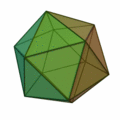Twenty
| Twenty | |
|---|---|
| 20th | |
| presentation | |
| Roman | XX |
| dual | 1 0100 |
| Octal | 24 |
| Duodecimal | 18th |
| Hexadecimal | 14th |
| Morse code | · · - - - - - - - - |
| Chinese | 二十 |
| Mathematical properties | |
| sign | positive |
| parity | straight |
| Factorization | |
| Divider | 1, 2, 4, 5, 10, 20 |

The twenty (20) is the natural number between nineteen and twenty-one . She is straight .
Linguistic
The German numeral twenty comes from Old High German twenty and is a combination of two and the final syllable -zig , which means "tens", thus stands for two ten or two tens .
However, many languages have their own root word for that number, from the Indo-European original word * wi-k'm.ti- example, have the Greek εἴκοσι (eikosi) , the Latin viginti or Celtic variants Ugain in Welsh , ugent in Breton and fiche developed in Irish . These are references to the earlier use of a vigesimal system , which arguably arose from using the ten fingers and ten toes of the human body for counting. In some European languages numerals that go back to this twenty system can be found, for example in the Celtic languages , in Danish and French (cf. French quatre-vingt-seize - ninety-six - literally "four-twenty-sixteen"). The English expression score also stands for twenty , one counts one score, two score, ... (20, 40, ...).
The vigesimal system was also widely used in the advanced cultures of Central America, here there is also the form hun uinic , literally translated as "a man", which actually means counting on fingers and toes for the numeral in some Mayan dialects next to hun kal , "a twenty" of a person. In the Maya language there are also simple words for the powers of 20, i.e. for 400, 8000 and 160,000.
The prefix (e) ikos- comes from the Greek εἴκοσι, from the Latin viginti with the ordinal number vigesimus , the twentieth, the forms vigint- and vigesim- , which are used in foreign words, examples: eikosanoid .
From the English word twenty , the term Twen was formed for people between the ages of 20 and 29 in German in analogy to the term teenager (short form: Teen ) .
Math
20 is the fourth tetrahedral number . The icosahedron consists of 20 faces, while the pentagonal dodecahedron, which is dual to the icosahedron, has 20 corners.
Culture and society
- Love at Twenty is an international episode film by various important film directors from 1962.
- From twenty to thirty by Theodor Fontane
- Twenty is the name of an album by the US rock band Lynyrd Skynyrd and the US blues musician Robert Cray .
- The Maya calendar , like the number system, is essentially based on the 20 base.
- In Japan , 20 traditionally denotes the age of majority .
- Société des Vingt , German Society of Twenty , was the name of a French art association in the 19th century
- In the Middle Ages the double number of the Ten Commandments and thus their meaning doubled by love in action and attitude
physics
- One of the magic numbers of atomic nuclei.
literature
- Georges Ifrah: Universal History of Numbers. Campus, Frankfurt am Main 1991, ISBN 3-88059-956-4 .
See also
- The year 20
- 20th century
- Group of the twenty most important industrialized and emerging countries (G20)
- Twenty-sheet clause
- Twenties
Web links
Individual evidence
- ^ Ernst Hellgardt: On the problem of symbolic and formally aesthetic number composition in medieval literature. With studies on the quadrivium and the prehistory of medieval number thinking. Munich 1973 (= Munich texts and studies on German literature of the Middle Ages. Volume 45).
- ^ Heinz Meyer, Rudolf Suntrup: Lexicon of the meanings of medieval numbers. Munich 1987 (= Münstersche Mittelalter-Schriften. Volume 56), pp. 669–675.


